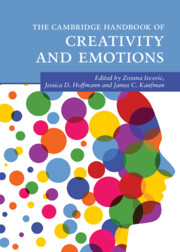Book contents
- The Cambridge Handbook of Creativity and Emotions
- Cambridge Handbooks in Psychology
- The Cambridge Handbook of Creativity and Emotions
- Copyright page
- Dedications
- Contents
- Figures
- Tables
- Contributors
- Acknowledgments
- Creativity and Emotions
- Part I Methods in the Study of Creativity and Emotions
- Part II The Development of Creativity
- Part III Emotions and the Creative Person
- Part IV Emotions and Creative Products
- 17 Emotional Creativity
- 18 Affective Factors in Dark Creativity
- 19 For Emotion’s Sake … The Centrality of Emotions in the Art Experience
- 20 The Affective Benefits of Creative Activities
- 21 Everyday Creativity as a Pathway to Meaning and Well-Being
- 22 Creative Arts Therapies
- 23 Developing Emotion Abilities through Engagement with the Arts
- Part V Emotions and Creativity at School and Work
- Index
- References
23 - Developing Emotion Abilities through Engagement with the Arts
from Part IV - Emotions and Creative Products
Published online by Cambridge University Press: 16 February 2023
- The Cambridge Handbook of Creativity and Emotions
- Cambridge Handbooks in Psychology
- The Cambridge Handbook of Creativity and Emotions
- Copyright page
- Dedications
- Contents
- Figures
- Tables
- Contributors
- Acknowledgments
- Creativity and Emotions
- Part I Methods in the Study of Creativity and Emotions
- Part II The Development of Creativity
- Part III Emotions and the Creative Person
- Part IV Emotions and Creative Products
- 17 Emotional Creativity
- 18 Affective Factors in Dark Creativity
- 19 For Emotion’s Sake … The Centrality of Emotions in the Art Experience
- 20 The Affective Benefits of Creative Activities
- 21 Everyday Creativity as a Pathway to Meaning and Well-Being
- 22 Creative Arts Therapies
- 23 Developing Emotion Abilities through Engagement with the Arts
- Part V Emotions and Creativity at School and Work
- Index
- References
Summary
The arts have long been tied to various emotional processes, both as a way for artists to express their emotions, and for audiences to understand the emotions of themselves and others. Therefore, engaging in the arts across childhood and adulthood is often hypothesized as a way to foster emotion abilities. While there is burgeoning evidence of various emotional skills such as emotional intelligence, emotional control, and empathy being fostered through artistic engagement, many questions remain. These include questions about the exact skills and behaviors within emotional processing and functioning that are affected; whether each art form (i.e. dance, music, theatre, visual arts, cinema, etc.) differentially affects emotion abilities; whether there are critical periods for engagement throughout the developmental trajectory of childhood and the lifespan; and the possible psychological, neurological, and environmental mechanisms for these changes. This chapter presents recent empirical evidence for what we know about engaging with the arts as a producer and consumer, particularly focused in middle childhood, and the development of various emotion abilities. As a whole, the literature points to inconsistent findings and large gaps in knowledge; future directions are proposed.
- Type
- Chapter
- Information
- The Cambridge Handbook of Creativity and Emotions , pp. 434 - 458Publisher: Cambridge University PressPrint publication year: 2023
References
- 1
- Cited by



